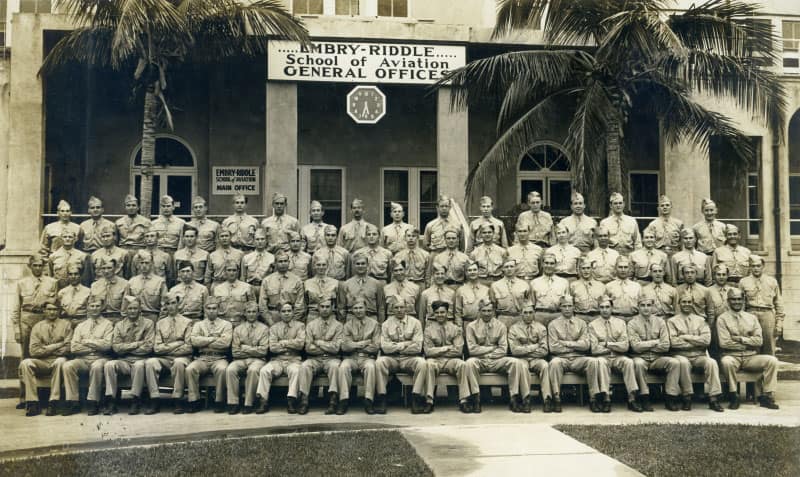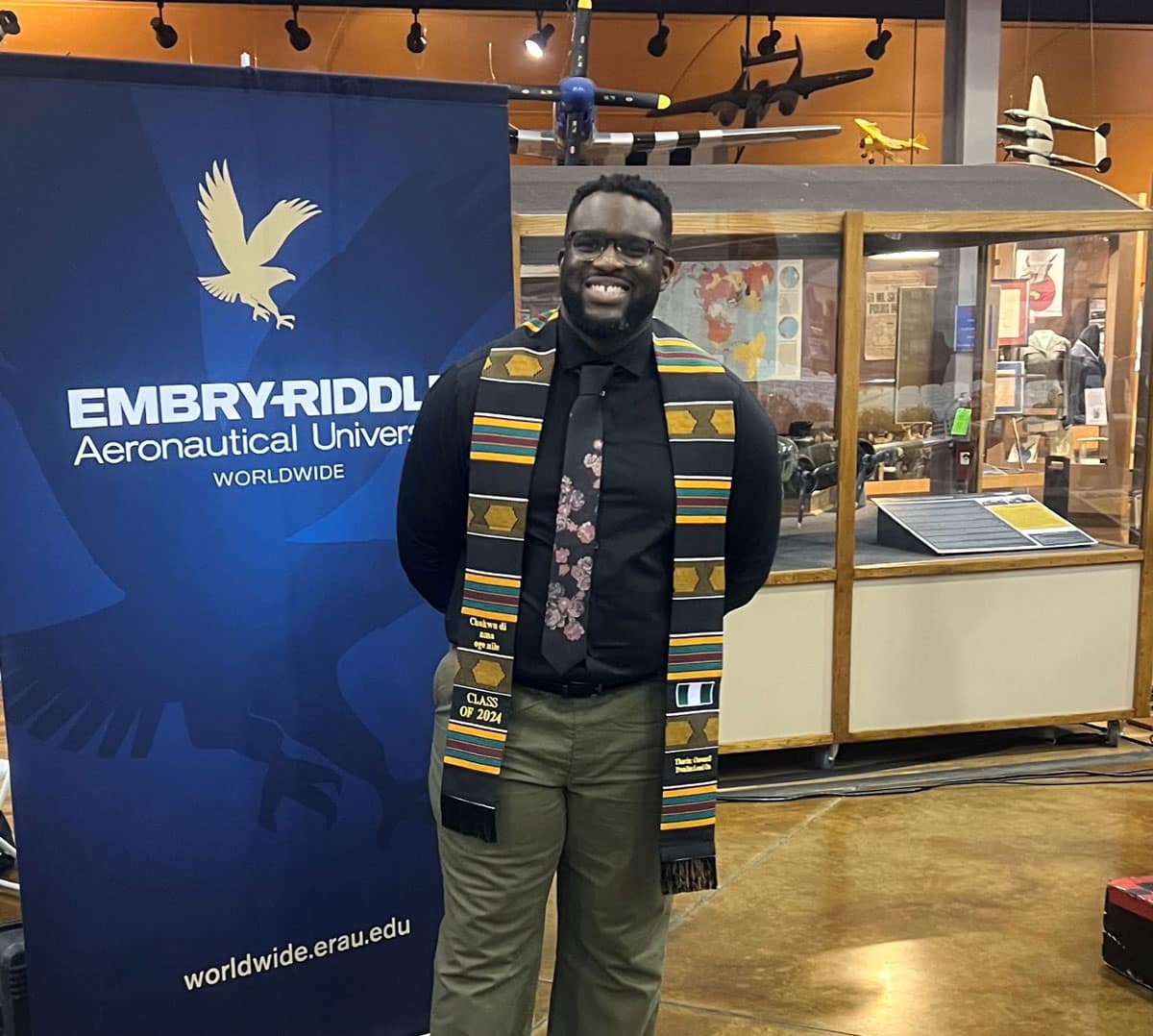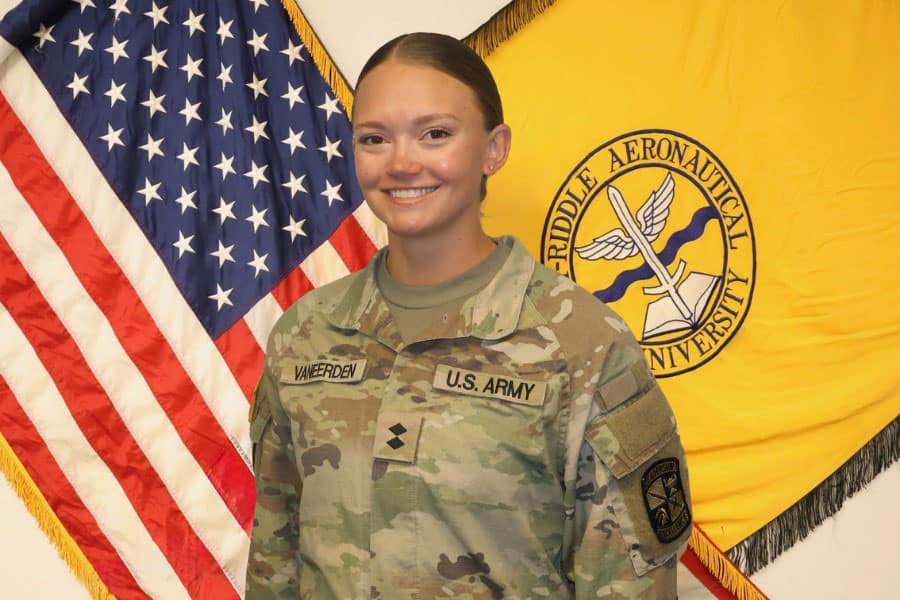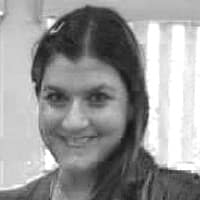A Proud Tradition: Embry-Riddle Marks Decades of Supporting the Military and Shaping Future Leaders

U.S. Air Force 2nd Lt. David Mehl is proud to have followed in his older brother’s footsteps — both as a military jet pilot and a member of Embry-Riddle Aeronautical University’s Air Force ROTC Detachment 157.

A WWII cadet class poses outside the entrance of Embry-Riddle School of Aviation General Offices in Miami, Florida. (Courtesy of Embry-Riddle Aeronautical University Archives) “Ian has always been my biggest mentor,” said David, who graduated in May and will be starting combat pilot training for the Air Force Euro-NATO Joint Jet Pilot Training Program in the spring.
U.S. Air Force Capt. Ian Mehl, who is seven years older than David, grew up knowing he wanted to fly and serve his country. After hearing that Embry-Riddle had a high success rate in placing cadets in pilot roles, he visited the university’s Daytona Beach, Florida, campus. He knew he had found the right place.
“I fell in love with the school and felt connected right away," said Ian, who is currently an F-35 instructor pilot stationed at Eglin Air Force Base in the Florida Panhandle. “Embry-Riddle couldn’t have set me up better for success going into the Air Force.”
From training American and British pilots during World War II in the 1940s to currently producing one of the largest numbers of military aviators, Embry-Riddle has a long and proud history of supporting the armed forces.
From WWII to Top-Ranked ROTC Units

British cadets arrive for flight training at Clewiston Airfield in Florida. Embry-Riddle stepped up in 1941 to help fill the growing demand for flight training for American and British WWII pilots. (Courtesy of Embry-Riddle Aeronautical University Archives)
When Embry-Riddle was a small Miami-based civilian aviation school, it stepped up in 1941 to help fill the growing demand for training for WWII pilots. It conducted training for the U.S. Army Air Corps/Army Air Forces and British Royal Air Force at five airfields around South Florida, including its Miami seaplane base.
“All these cadets needed flight training,” said Dr. Stephen Craft, professor and chair of the Security Studies and International Affairs Department and author of the book, “Embry-Riddle at War.”
“Embry-Riddle’s contribution to the war effort was training these cadets before and during WWII,” he said.
As Embry-Riddle marks its centennial, that commitment to the military remains as strong as ever.
The university’s highly ranked ROTC programs have a reputation for graduating numerous top-notch cadets, and the university makes it a priority to provide them with the resources they need for success. Alumni from the university’s ROTC programs frequently return to campus to share their experiences and encourage cadets.
“When I think of Detachment 157, it feels like home,” said Ian Mehl. “It is such a standout detachment in the country, and the friendships and connections I’ve made I will have my whole life.”
Air Force ROTC Detachment 157 was founded in 1972, with its first commissioning class in 1973. Since then, it has produced some 2,100 officers, said Col. Gregory Adams, commander of the detachment.
“Det. 157 is very unique in the opportunities that you have to lead,” said David Mehl. “And the standard for excellence is so high that you are pushing each other day in and day out to make each other better and make Detachment 157 the best in the country.”
Embry-Riddle Air Force ROTC cadets are consistently selected for highly competitive Air Force pilot training programs. In spring 2025, seven cadets, including David Mehl, were chosen for the Air Force Euro-NATO Joint Jet Pilot Training Program.
“When you combine the two detachments, one-fifth of Air Force ROTC graduates attending Euro-NATO Joint Jet Pilot Training in 2025 came from Embry-Riddle,” said Col. Russ Davis, commander of Air Force ROTC Detachment 028 at Embry-Riddle’s Prescott, Arizona, campus and professor of Aerospace Studies. “That is a testament to the quality of the university and our outstanding AFROTC programs.”
Army ROTC Eagle Battalion came to Embry-Riddle in 1982 and saw its largest commissioning class of 64 Second Lieutenants produced in 2022-2023, said Lt. Col. Jerome Reitano, professor of Military Science at Embry‑Riddle. Last year, the battalion had a 100% selection rate, with seven cadets selected for active-duty Army Aviation.
Embry-Riddle’s Navy ROTC program, established in 2003, has produced 634 commissioned officers since its inception, said Capt. Carlos A. Medina, the program’s commanding officer and professor of Naval Science. Over the past three years, the unit commissioned 117 Naval officers and Marines, including 41 Student Naval Aviators, 10 Student Naval Flight Officers and seven Marine Aviators.
Serving Those Who Serve

Student veteran Fitzgerald Ihekwoaba said he found encouragement and support when he decided to pursue his bachelor’s and master’s degrees at Embry-Riddle’s Worldwide Campus. (Photo: Embry-Riddle/Fitzgerald Ihekwoaba)
Embry-Riddle has a long tradition of educating and training veterans and active-duty servicemembers. In 1944, Embry-Riddle became one of the first aviation schools to train veterans under the GI Bill. In 1970, it opened its first residence center for military students looking to earn their degree at the U.S. Army Aviation Center in Fort Rucker, Alabama.
Today, Embry-Riddle consistently ranks among the nation's top military- and veteran-friendly schools, and the university educates numerous students affiliated with the military around the globe through its Worldwide Campus.
Student veteran Fitzgerald Ihekwoaba said he found encouragement and support when he decided to pursue his bachelor’s and master’s degrees at Embry-Riddle’s Worldwide Campus. He served more than 10 years as an active-duty Navy aviation mechanic, and he has been a member of the naval reserves since 2022.
Ihekwoaba, who lives in Dallas, Texas, has had the opportunity to study abroad, participate in student organizations and mentorship programs, plus complete an aviation safety internship with the Federal Aviation Administration.
Ihekwoaba, who is currently earning his master’s degree in Aeronautics with a specialization in Aviation Safety, said he is proud to be part of Embry-Riddle’s legacy.
"Being part of Embry-Riddle’s 100-year history means contributing to a century of growth, change, and relentless pursuit of excellence in aviation and aerospace,” he said. “I see this milestone as a reminder of how far we’ve come — and how much further we can go. Moving forward, I hope to improve aviation safety from the ground up, ensuring the next 100 years are even safer and more innovative."
Setting a High Bar

Aerospace Engineering student Karalyn VanEerden said joining the university’s Army ROTC Eagle Battalion changed her life and set her up for success. (Photo: Embry-Riddle/Karalyn VanEerden)
Karalyn VanEerden, who is from St. Marys, Pennsylvania, came to Embry-Riddle for its top-rated Aerospace Engineering program, but she said discovering the university’s Army ROTC Eagle Battalion changed her life.
“I was not in Army ROTC my first semester,” said VanEerden. “But everyone I met that I really liked ended up being in Army ROTC, so I was interested in becoming a part of it.”
It is not easy balancing a challenging academic load with early morning runs and training sessions, but VanEerden said the program's structure and the support from her fellow cadets motivate her to do her best.
“The standard we set for each other physically and academically is really high,” she said. “Surrounding myself with that, I’m more disciplined and I’ve gained a ton of leadership skills. The program has made me a much better person and set me up for my future.”
VanEerden is looking forward to graduating in December and having her sister, a U.S. Navy veteran, swear her in as an officer. She intends to pursue a civilian career conducting Department of Defense research.
Like David and Ian Mehl, she said Embry-Riddle’s ROTC program gave her the discipline, strong friendships and leadership opportunities she needed to reach her goals.
“Going through the program and seeing other schools, it’s become more and more clear how special Embry-Riddle’s program is and how they are committed to giving us the best experience possible,” said VanEerden. “I’m very grateful for that because it’s set me up for success in so many ways.”

 Melanie Stawicki Azam
Melanie Stawicki Azam